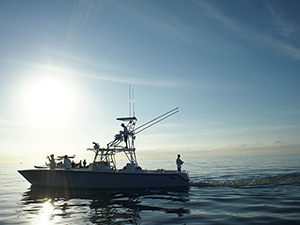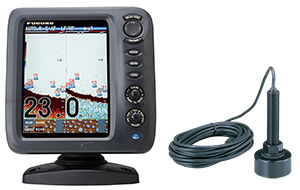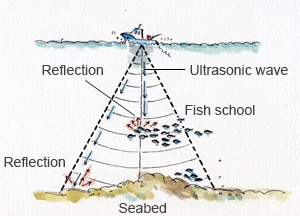 Topic 02 - How they work?
Topic 02 - How they work?

A fish finder helps detect a fish school and provides various underwater information, such as water depth, distribution of fish school, and the condition of the seabed by transmitting ultrasonic waves into the sea and receiving its reflection. Part of sonic or ultrasonic waves, which have been transmitted, reflect back to the source when they hit an object (e.g. fish school or seabed). A fish finder uses this ultrasonic reflection characteristic.
The ultrasonic waves from the fish finder are transmitted directly underneath the boat. If they hit a fish school, very weak reflections will come back to where the ultrasonic waves were originally transmitted. The reflection received is converted into an electrical signal and subsequently sent to the receiving circuit of the fish finder. The receiving circuit amplifies the weak signals, and the processor unit processes them to generate images to be displayed on the screen. As the result, the image will be displayed on the color LCD. Stronger reflections are shown in orange or red, and weaker ones are shown in green or blue on the screen. A fish school of high density or rocks on the seabed return stronger signals, so they will be shown in a reddish color, while a fish school of low density or small fish will be shown in a bluish color. The color presentation can clearly illustrate the undersea condition.

A fish finder consists of two parts: main unit (with a screen) and transducer. The main unit should be located where it can be easily accessed in the cabin or wheelhouse, etc. The transducer should be mounted on the boat's bottom either through hull or in-hull installation. Please bear in mind that the performance of a fish finder depends largely on whether the transducer is properly mounted on the boat's bottom. An improperly mounted transducer may result in failure in capturing reflected waves or other serious defects. To avoid these troubles, you should consult with a technical dealer on how to properly install the transducer prior to actual installation.
